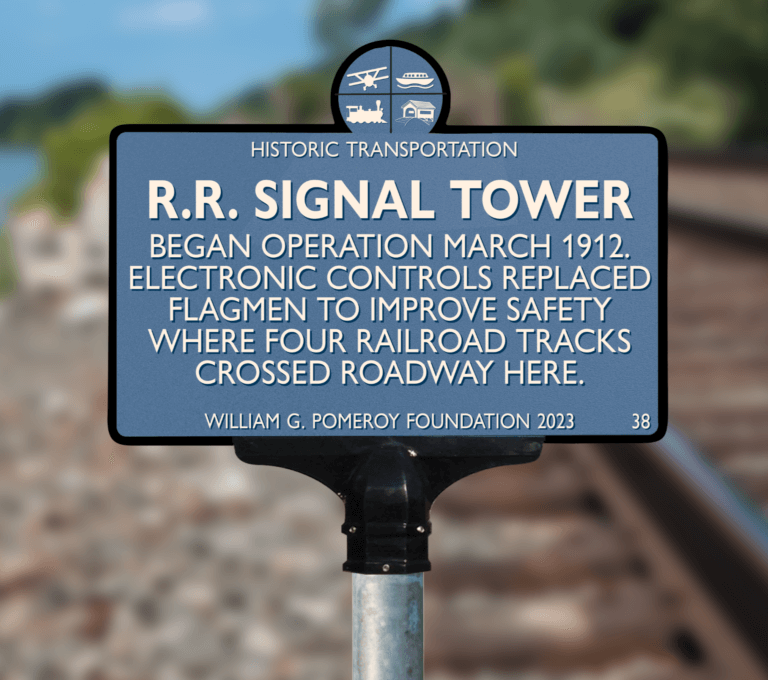Historic Transportation Marker Grant Program

The following subjects qualify for Historic Transportation marker grants:
CANALS
Often considered a precursor to interstate highways, transportation canals helped facilitate the movement of goods and people. This spurred development of towns and villages along the way, leading to an overall expansion of the nation.
BRIDGES and TUNNELS
Bridges and tunnels allowed people to overcome natural obstacles such as rivers and mountains, expediting travel. If a bridge has been rebuilt or restored after 1945, components of the original structure must still be extant.
RAILROADS
Existing railroad structures such as depots, stations, rail cars and engines will be considered. Trolleys and interurbans are included in this category. Applications for former railbeds that lack an existing structure will not be accepted for this marker program.
AIRCRAFT
Existing airfields, hangers, planes and other aircraft will be considered. Use for transportation of goods or people must be proven.
Eligibility
Historic Transportation grants are available to 501(c)(3) organizations, nonprofit academic institutions, and local, state and federal government entities within the United States. Interested individuals are encouraged to contact an eligible local organization, such as a municipal historian or historical organization. They will often apply for the grant on behalf of the individual.
Historic Transportation markers must recognize a historical fact that occurred by 1945. After World War II, the United States saw a significant change in transportation with the increase in automobile ownership and the construction of the interstate highway system. We seek to commemorate the way in which goods and people were transported prior to these transformative events.
- Marker inscription must be proven with primary source documentation.
- Subject must be historically significant to the larger community or beyond.
- Inscriptions must be clear about why the subject is historically significant.
- Inscriptions should maximize available character limits.
- Key dates must be included for framing context.
- Markers must be installed near an existing site or structure. Applications for structures that no longer exist or are slated for removal will not be successful.
- Structures must be publicly accessible for viewing.
Marker Design and Text Guidelines
The colors of the markers are blue with white lettering and a black border. Markers are 18” x 32” cast aluminum with a 7’ aluminum pole.
The title line allows 15 characters and the five body lines can have 27 characters each, including spaces and punctuation. There is a required credit line at the bottom of the marker which is always included.
Please review our marker inscription style guide as you prepare your application: Marker Style Guide
Historical Accuracy
Primary source documentation is required to verify historical accuracy. The applying agency is responsible for supplying photocopies, scans or photos of the sources and specific statements used to verify historical facts. If selected, the strength of the supporting materials substantially lessens the time between acceptance and funding. If the Pomeroy Foundation cannot substantiate the historical accuracy of the proposed marker text based on the supporting documentation provided, the opportunity for approval is limited.
Application Deadlines in 2025
Important Dates
ROUND 1
- 3/14/25 – Application becomes available online
- 4/11/25 – Deadline to submit Letter of Intent (LOI) to verify primary sources.
- 5/16/25 – Application deadline
- August 2025 – Grants awarded
ROUND 2
- 9/5/25 – Application becomes available online
- 10/3/25 – Deadline to submit Letter of Intent (LOI) to verify primary sources.
- 11/7/25 – Application deadline
- February 2026 – Grants awarded
Grant Application Procedure
Letter of Intent
A Letter of Intent (LOI) is an online form that must be completed to demonstrate your interest in applying for a marker. A completed LOI is required prior to submitting your application. Each LOI includes information such as proposed marker text and a list of primary sources. To submit your LOI, you must log in to your account and click apply at the top of the page which will bring you to the available applications. Click the blue apply button at the top right corner of the Historic Transportation marker description; that will bring you directly to the LOI page. Once the LOI is reviewed and approved, you will receive a notification by email that allows you to begin the application stage.
Applications
Applications are only accepted online. To create an account and apply, please use this link: Apply for Grant
Applications must include the following:
- the applying agency’s information
- contact information for the person responsible for the application
- proposed installation location in specific detail (including GPS coordinates)
- a brief description and historical significance of the subject being commemorated
- proposed inscription for marker
Additional required documents are:
- a letter from the landowner granting permission for the marker to be installed
- copies of the primary source documents supporting all the proposed text on the marker
Grants for the Historic Transportation program cover the entire cost of a marker, pole, and shipping. There is no cost to you. If your application is approved, upon receipt of your signed Acceptance Letter, the William G. Pomeroy Foundation will mail a check for the total amount made payable to the applying agency. Instructions for ordering your marker will accompany the check. The grant recipient is responsible for installation of the marker.
Marker Placement
Please carefully consider the location where the marker is to be installed.
- Markers should not be placed on high-traffic roadways or roadways where vehicles are traveling at a high rate of speed if there is no place for a vehicle to safely pull over out of traffic.
- Markers should not be placed where the visitor must intrude on private property to read it or view a site related to the marker inscription.
Before installing your marker, please be sure you are following all of your state’s guidelines around digging and excavation.
Questions?
Contact Christy at info@wgpfoundation.org or 315-913-4060, Monday – Friday between 8:00 am and 4:30 pm (EST).
